Google My Business Categories: How to Choose Yours [+FAQ]
Leslie owns a local brewery.
She wants to drive more local customers to her business, so she decides to claim her Google My Business listing to help get more exposure. One of the first questions Google asks is for her to pick her Google My Business categories, but she doesn’t know what they are or how to find the right one.
If you’re like Leslie, you might be in a similar situation with your business — you may not know what Google My Business categories are or why you need them.
Luckily, we’ve got answers to your burning questions! We’ll answer questions like:
- What are Google My Business categories?
- Why should I use Google My Business categories?
- How do I choose the right categories for my business?
Plus, we’ll answer additional common questions in our FAQ section! Keep reading to learn more!
Sign up today!
For even more digital marketing advice, sign up for the email that more than 150,000 other marketers trust: Revenue Weekly.
What are Google My Business categories?
Google My Business categories are labels that help your business appear in relevant search results. Google enables you to add up to 10 categories — including one primary category — that describe your business. The list of Google My Business categories contains nearly 4000 options.
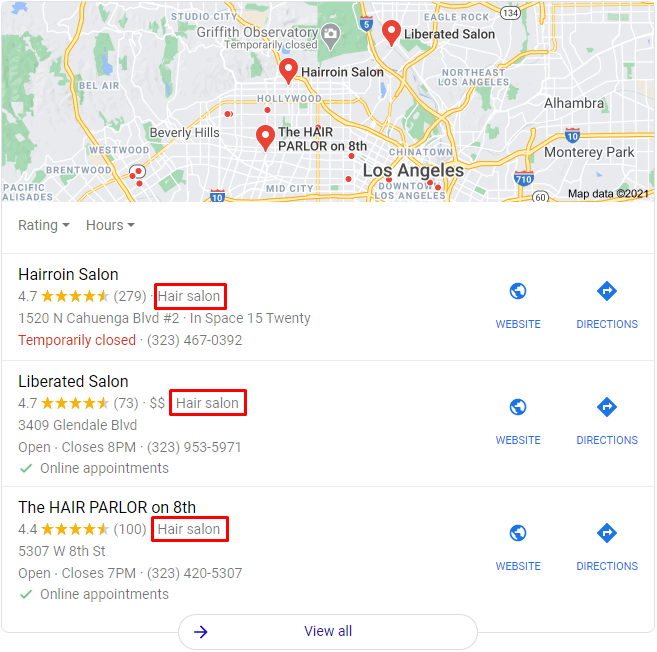
Why should I use Google My Business categories?
Now that you know what Google My Business categories are, you may wonder why they’re important. How do they enhance your local listing?
Google business categories play a fundamental role in where your company appears in search results. By adding categories to your listing, you indicate your type of business to Google, which helps Google show your company in relevant search results.
Choosing your category also determines what features you get on your local listing.
Here are a few scenarios where the category impacts the listing features:
- Restaurant categories give businesses access to features like online ordering and adding menus to their listing
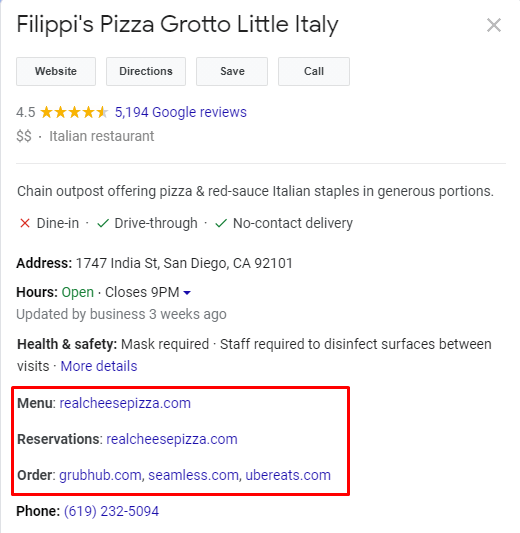
- Health and beauty categories give businesses access to booking for appointments
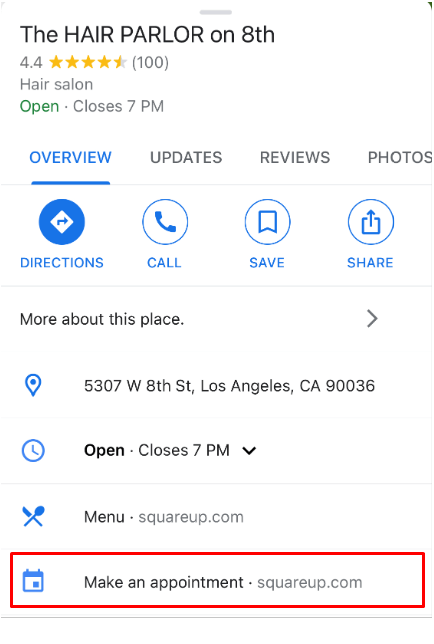
- Hospitality categories give businesses access to show the quality rating, amenities offered, and check availability features
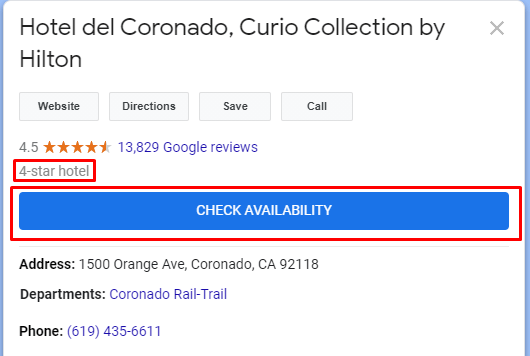
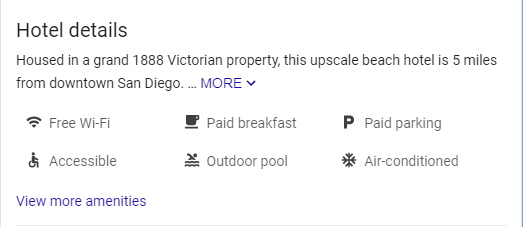
How do I choose the right categories for my business?
Now that you know the importance of selecting your Google My Business category, you’re eager to dive in and choose yours. So, how do you choose categories for your listing?
First, start by either creating or claiming your Google My Business listing.
If you’re creating your Google My Business listing, Google will immediately ask you for a business category. You can always go back and change this later if you don’t have your list of categories you want to use.
If you’re claiming your listing, you can change your categories by following these steps:
- Sign in to your Google My Business account
- Click the Edit button to change your primary category
- Click the Add Another Category button to add categories
- Add the categories
- Click Apply
Now that you know how to apply categories, it’s time to choose the right ones.
Here are two ways you can get ideas for listing categories:
1. Come up with a list of terms related to your business
To help you come up with your list of Google My Business categories, start by generating a list of terms related to your business. You want to create a list of general and specific terms to determine the right categories for your company.
For example, let’s say you own a family-owned Italian restaurant. To start your list, you may add a broad term like “restaurant.” As you get more specific with your categories, you may add words like “Italian restaurant” and “family restaurant” to your list of Google My Business categories.
You may also add some terms related to your products, like “Italian food” or “Italian cuisine.”
Keep going on with this process until you’ve generated an extensive list of options.
You’ll want to make a list of potential Google My Business categories to help you, eventually, narrow down your focus and concentrate on categories that will drive the most qualified traffic.
To help with that process, you can use a keyword research tool and plug in your categories to see the keyword volume for that term. It can help you determine which keywords have a decent enough volume for you to target them.
2. Look at your competitors’ categories
If you’re looking for some inspiration when creating your list of Google My Business categories, you can turn to your competition. You want to look at what categories your competition uses to ensure you’re competing in your local market.
To start finding relevant terms, you must determine the radius of your local market. Your local market can be as small as a neighborhood or as big as a city. You’ll need to decide how far out you want to search.
Once you have a general idea of the radius, you’ll want to note all the businesses in the surrounding area that qualify as competition.
After generating your list, download the Chrome plugin called GMBspy. When you install this plugin, you can look at any business on Google Maps and get a list of category keywords for that company.
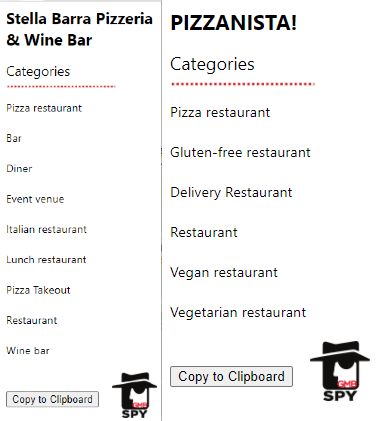
It’s an excellent way for you to generate category ideas and ensure you’re competing with your competition in relevant search results.
Google My Business categories FAQ
Here are some common questions people have when trying to choose their Google My Business categories!
How many categories should I add?
One of the most common questions about Google categories for business regards the number of categories. Google enables you to add up to 10 categories to your listing. While there are 10 slots available, it doesn’t mean you need to use all of them!
When choosing tags, don’t add a tag for every single service or product type you offer. Instead, focus on generic terms that describe what your business does or the type of business you run.
For example, if you own a sporting goods store, you wouldn’t add categories for every sport you service. Instead, you’d want to use a generic category like “sporting goods” or “sports supplies.”
If your business offers more than one type of service, use generic terms for those services too.
For example, many grocery stores have pharmacies and delis. So, in your category list, they could add “Pharmacy” and “Deli” in addition to “Grocery Store” as product categories.
Are there any instances where I shouldn’t use a certain category tag?
Yes. If you have another independently operated business operating within your company’s location, you don’t want to use any categories that describe that business on your listing.
So, what does this mean?
Let’s look at Target to explain this better. Many Targets across the country have a Starbucks within them. Even though Starbucks uses Target’s retail space to serve guests that visit, it’s still independently owned by the Starbucks Corporation.
So, when Target chooses their Google business categories, they wouldn’t be able to put “Coffee Shop” as a category option because Target doesn’t own Starbucks. Instead, Starbucks would have to create a separate Google My Business listing and add the “Coffee Shop” category tag to their listing.
You can see an example of the two separate listings from the same location below:
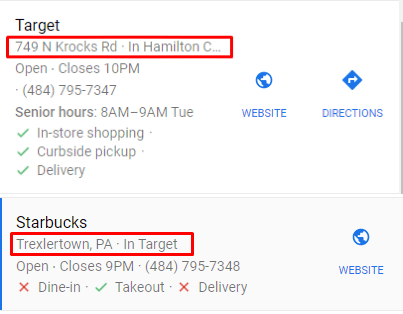
In general, you’ll want to keep your categories specific to your business and choose your categories selectively to get the most from your local listing.
How often can I change my categories?
Whether you choose one Google My Business category or multiple, there may come a point when your categories need to change, or you find ones that are more relevant to your business. So, that begs the question: How often can you change your categories?
Google doesn’t put a specific limit on how many times you can change your categories. If you change your categories often, especially in a short period, Google may have you verify your business’s information to ensure the changes are legit.
Can I create my own category?
No — Google only enables you to choose from the list of categories they have available in their list of Google My Business categories.
What do I do if Google doesn’t offer my category?
Many businesses run into the issue where, when looking at the Google categories for businesses, they don’t see one that accurately describes their organization. So, what do you do at this point?
If you run into this issue, you’ll have to choose a category that most accurately describes your business.
For example, if you own an organic cleaning service business, you may not see a category that addresses your cleaning business’s organic aspect. You may have to choose a category like “House Cleaning Service” or “Cleaning Service” and omit the organic part of your business.
However, that doesn’t mean that a tag like that won’t come along in the future! Google continually adds new category tags to their list, so you can check back and see if they end up adding a more relevant category tag for your business.
Get help optimizing your Google My Business listing
Besides your Google My Business categories, there are other aspects of your Google My Business listing you’ll want to optimize to drive local leads for your company. At WebFX, we have a team of over 250 experts that can help you optimize your listing.
We know how to craft campaigns that our clients love — that’s why we have over 500 glowing client testimonials!
If you’re ready to get started, contact us online or call us today at 888-601-5359 to speak with a strategist about our local SEO services!